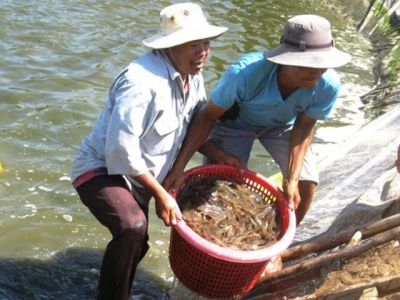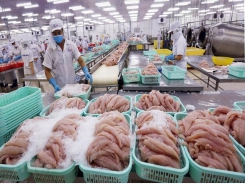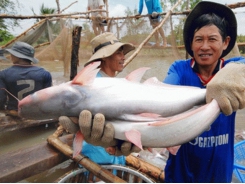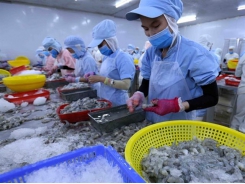Ministry carries out measures to recover shrimp export markets

Since the beginning of this year, prolonged hot weather and saltwater intrusion have caused disadvantages for shrimp-farming areas in the Mekong Delta. Besides, the Covid-19 pandemic has also affected the export of shrimps, leading to a decline in export turnover.
Farmers harvest shrimps in Soc Trang Province. (Photo: SGGP)
Amid these aforesaid difficulties, the Ministry of Agriculture and Rural Development (MARD) and competent authorities have been carrying out measures to recover production and promote shrimp exports in the future.
According to the MARD, shrimp farming conditions in the Mekong Delta in the first months of this year were not favorable due to severe saltwater intrusion and drought, along with unseasonal rains and relatively high diurnal temperature fluctuations. Although provinces had built solutions to cope with the situation, the shrimp farming rate remained slow. Statistics showed that since the beginning of this year, provinces in the Mekong Delta have raised shrimps on an area of more than 481,534 hectares, accounting for 84 percent compared to the same period last year. In the past days, more than 15,950 hectares of shrimps were damaged, 3.3 times higher over the same period last year. Mr. Tran Dinh Luan, Director General of the Vietnam Directorate of Fisheries, said that to cope with unfavorable weather, experts recommended that farmers should extend the shrimp crop, keep low stocking density, and apply advanced procedures to limit risks; provinces should closely watch the developments of weather and frequently monitor the environment to timely inform farmers for precautions.
Along with obstacles in shrimp farming, the export of shrimps has also faced difficulties. According to the Vietnam Directorate of Fisheries, by the end of March, the country’s shrimp exports merely reached $591 million, down 4.3 percent over the same period last year as the Covid-19 pandemic occurred in many countries in the world. Exporters said that shrimp consumption in the first quarter of this year in the Chinese market declined due to the impacts of the Covid-19 pandemic. Specifically, since the Lunar New Year, trade by road with China was closed. Official trade and trade by sea encountered sluggishness and postponement of orders, leading to increased expenses due to arising storage and inventory costs. Besides, the transportation of shrimp products to the international market was also disturbed as many shipping lines did not accept to transport goods to China, some stopped providing containers to China, leading to the change of transporters, and higher transportation costs.
Exporters also said that, traditional European customers usually come to Vietnam to visit factories and consider signing new contracts every year. However, so far, many customers have canceled their visiting schedules, meaning that the number of new contracts has been reduced. Due to sluggish export, the prices of material shrimps in the Mekong Delta in the first quarter of this year decreased by 20 percent over the same period last year.
Vietnam Association of Seafood Exporters and Producers (VASEP) said that shrimp exports from the beginning of the year until now have come to a stop due to the impacts of Covid-19 pandemic, however, it is expected to recover later and accelerate at the end of this year. VASEP analyzed that despite a decrease in shrimp exports to the EU last year, it should be seen that the EU-Vietnam Free Trade Agreement is expected to take effect in June this year, then the import tax of most material shrimps into the EU will reduce from the basic tax rate of 12 -20 percent to zero percent right after the agreement comes into effect; the import tax for processed shrimps will also be zero percent after 7 years since the agreement comes into effect.
The advantage is that the EU has a high per capita income, the more utilities the products have, the more they are favored. The market segment is broad enough for Vietnamese businesses to choose the distribution network. Thereby, shrimp exports to the EU are forecast to be positive thanks to tariff preferences and Vietnamese shrimps can compete better than those of India, Thailand, and Indonesia. This year, Vietnam’s shrimp exports to the EU will increase by around 15 percent to $800 million.
For the US market, demand for farmed shrimp is always high and from the end of last year, US importers have been buying shrimps from Vietnam more actively. In August last year, the US Department of Commerce announced the final result of the 13th period of review on anti-dumping tax on Vietnamese shrimps to the US with 31 enterprises enjoying zero percent tax; this has created more motivation for Vietnamese enterprises to export shrimps to the US.
Japan market is the third-largest shrimp importer of Vietnam. It is forecast that shrimp exports to Japan this year will be about $620 million, the same as that in 2019. As for the Chinese market, despite having been stagnant in the first months of this year, according to experts' analysis, shrimp exports will be likely to increase again from the second quarter onwards and will possibly maintain the growth rate of 10 percent for the whole year, reaching a turnover of about $600 million.
Agricultural Minister Nguyen Xuan Cuong proposed provinces, associations, and seafood enterprises, from now until the end of the year, to focus strongly on shrimp farming to ensure the total farming area of about 730,000 hectares of shrimp and shrimp production of 830,000 tons. Besides, they should exploit well export markets such as the EU, the US, Japan, and China, and pay attention to new markets such as Russia and Poland; at the same time, pay more attention to the consumption of shrimp products in the domestic market. Despite many difficulties, the country will strive to achieve the export target of shrimps of about $3.5 billion this year, up 2-3 percent compared to last year.
In the long term, Minister Nguyen Xuan Cuong said that it is necessary to reasonably zone the shrimp-farming areas again, taking into account extreme weather conditions and climate change, increase the application of new technology in shrimp farming, ensure clean raw materials; invest in hatcheries; promote linkages between processing enterprises and cooperatives and farmers; encourage the use of biological products, organic and sustainable farming. Shrimp farmers should not focus on increasing the area but improving the quality of products to meet more demanding markets, bringing in high value.
Có thể bạn quan tâm
Phần mềm

Phối trộn thức ăn chăn nuôi

Pha dung dịch thủy canh

Định mức cho tôm ăn

Phối trộn phân bón NPK

Xác định tỷ lệ tôm sống

Chuyển đổi đơn vị phân bón

Xác định công suất sục khí

Chuyển đổi đơn vị tôm

Tính diện tích nhà kính

Tính thể tích ao hồ




 Hi-tech shrimp cultivation bring in a three or…
Hi-tech shrimp cultivation bring in a three or…  Australia to impose new regulations on prawn imports
Australia to impose new regulations on prawn imports